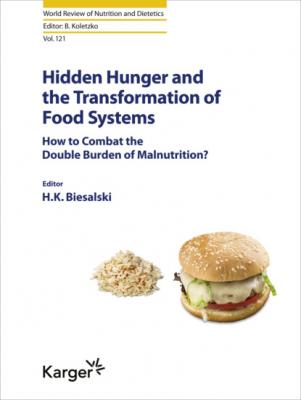Hidden Hunger and the Transformation of Food Systems. Группа авторов
Читать онлайн.| Название | Hidden Hunger and the Transformation of Food Systems |
|---|---|
| Автор произведения | Группа авторов |
| Жанр | Спорт, фитнес |
| Серия | World Review of Nutrition and Dietetics |
| Издательство | Спорт, фитнес |
| Год выпуска | 0 |
| isbn | 9783318066982 |
10Biesalski HK: Hidden Hunger. Berlin, Springer, 2013.
11Biesalski HK, Black R (eds): Hidden Hunger. Malnutrition and the First 1,000 Days of Life: Causes, Consequences and Solutions. World Rev Nutr Diet. Basel, Karger, 2017, vol 115.
12Jordan S, von der Lippe E: Angebote der Prävention – Wer nimmt teil? GBE kompakt 3. Berlin: Robert Koch Institut, 2012.
13Bauer U: Das Präventionsdilemma: Potenziale schulischer Kompetenzförderung im Spiegel sozialer Polarisierung. Wiesbaden, VS Verlag für Sozialwissenschaften, 2005.
14Federal Office for Agriculture and Food: Network “Gesund ins Leben.” https://www.gesund-ins-leben.de/ (accessed August 8, 2019).
15Kooperationsverbund Gesundheitliche Chancengleichheit: Gute Praxis für gesundheitliche Chancengleichheit – Die Good Practice-Kriterien und Praxisbeispiele. Berlin, Gesundheit Berlin-Brandenburg e.V., 2016.
16Koletzko B, Cremer M, Flothkötter M, Graf C, Hauner H, Hellmers C, Kersting M, Krawinkel M, Przyrembel H, Röbl-Mathieu M, Schiffner U, Vetter K, Weißenborn A, Wöckel A: Diet and lifestyle before and during pregnancy – practical recommendations of the Germany-wide Healthy Start – Young Family Network. Geburtsh Frauenheilk 2018;78:1–22.
17Koletzko B, Bauer C-P, Cierpka M, Cremer M, Flothkötter M, Graf C, Heindl I, Hellmers C, Kersting M, Krawinkel M, Przyrembel H, Vetter K, Weißenborn A, Wöckel A: Nutrition and physical activity of infants and breastfeeding women. Updated recommendations by “Healthy Start – Young Family Network” an initiative from IN FORM. Monatsschr Kinderheilkd 2016;164:771.
18Koletzko B, Armbruster M, Bauer CP, Bös K, Cierpka M, Cremer M, Dieminger B, Flothkötter M, Graf C, Heindl I, Hellmers C, Kersting M, Krawinkel M, Plöger A, Przyrembel H, Reichert-Garschhammer E, Schäfer T, Wahn U, Vetter K, Wabitsch M, Weissenborn A, Wiegand S: Nutrition and physical activity in children from 1–3 years old. Recommendations by the network “Healthy Start – Young Family Network”. Monatsschr Kinderheilkd 2013;161:1187–1120.
19Rosenbrock R, Michel C: Primäre Prävention: Bausteine für eine systematische Gesundheitssicherung. Berlin, MWV, 2006.
20Landesvereinigung für Gesundheit, Akademie für Sozialmedizin Niedersachsen: Werkbuch Präventionskette. Hannover, LVGAFS, 2013.
21Flothkötter M, Kunath J, Lücke S, Reiss K, Menzel J, Weikert C: Das internationale Forschungsvorhaben Becoming Breastfeeding Friendly. Untersuchung von Rahmenbedingungen zur Stillförderung. Bundesgesundheitsblatt Gesundheitsforschung Gesundheitsschutz 2018;61:1012–1021.
22Pérez-Escamilla R, Curry L, Minhas D, Taylor L, Bradley E: Scaling up of breastfeeding promotion programs in low- and middle-income countries: the “breastfeeding gear” model. Adv Nutr 2012;3:790–800
23Federal Office for Agriculture and Food: Nationales Qualitätszentrum für Ernährung in Kita und Schule (NQZ). https://www.nqz.de/ (accessed August 8, 2019).
Dr. Hanns-Christoph Eiden
President of the Federal Office for Agriculture and Food
Deichmanns Aue 29
DE–53179 Bonn (Germany)
Published online:
Biesalski HK (ed): Hidden Hunger and the Transformation of Food Systems. How to Combat the Double Burden of Malnutrition? World Rev Nutr Diet. Basel, Karger, 2020, vol 121, pp 16–20 (DOI:10.1159/000507519)
______________________
Unlocking the Hidden Hunger Crises: The Power of Public-Private Partnerships
Ilaria SchibbaKathryn OgdenMichael SmithEmily HeneghanFatiha TerkiBriony Stevens
United Nations World Food Programme, Rome, Italy
______________________
Abstract
The global burden of malnutrition remains unacceptably high. Malnutrition is a universal issue restricting development and slowing progress. Malnutrition is responsible for more illness and ill-health than any other cause worldwide. Despite underlying determinants of undernutrition being well understood for decades, millions of children worldwide face multiple malnutrition burdens, and women face a higher burden than men when it comes to malnutrition due to higher nutrient needs. Despite these alarming statistics, significant strides are being made. Globally, stunting rates among children have declined and many countries are on their way to achieving at least one nutritional status target for 2025. However, a broader range of stakeholders must be more fully engaged if malnutrition is to be reduced in a sustainable manner, including increased engagement from the private sector. To support achievement of the 2030 Sustainable Development Goal of ending all forms of malnutrition (goal 2.2), there must be urgent and decisive actions by all stakeholders to address existing data gaps, present new food systems innovations, ensure nutritious diets for all, fully finance nutrition action, and adhere to global commitments.
© 2020 S. Karger AG, Basel
The 2030 Agenda commits the world to eradicating all forms of malnutrition by 2030, but the pace of progress is slow and we are still far from reaching the Sustainable Development Goal (SDG) nutrition targets detailed in SDG 2: End Hunger. Every country in the world is affected by malnutrition, irrespective of wealth, and 88% of countries experience more than one type of malnutrition [1]. Additionally, there are countries experiencing a “double burden” or even a “triple burden,” with different forms of malnutrition coexisting within countries, households, and even individuals.
Over 2 billion people around the world suffer from a chronic deficiency of micronutrients [2]. Micronutrient deficiencies are estimated to impact a significant number of people worldwide, but there remains a paucity of information on micronutrient status and deficiencies. Myriad estimates refer to a figure of 2 billion; however, this reference is dated and often considers only four nutrients, while current research argues that at least 19 nutrients are needed [1]. This lack of essential
